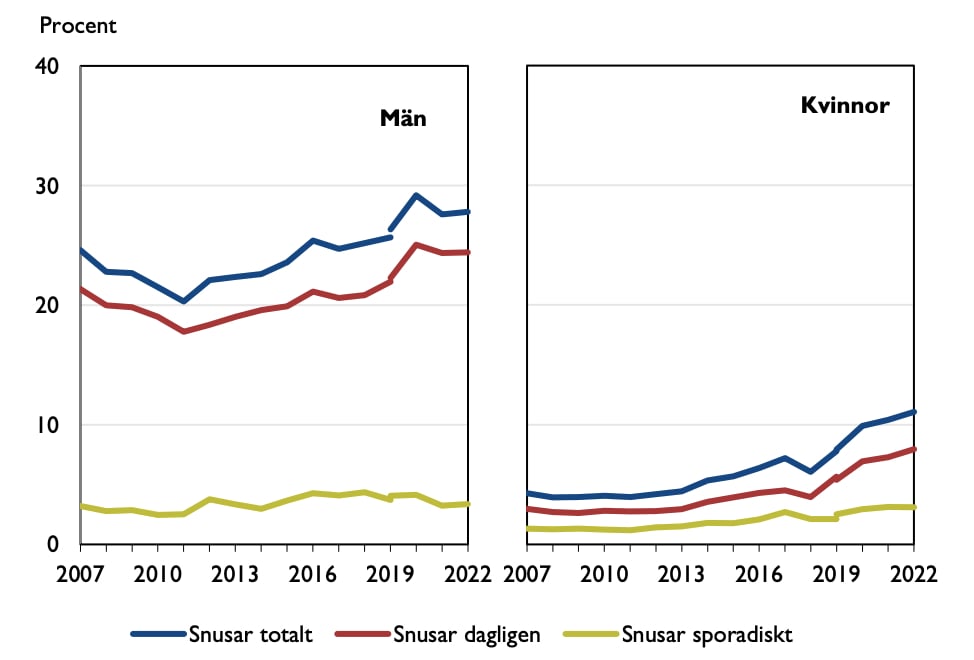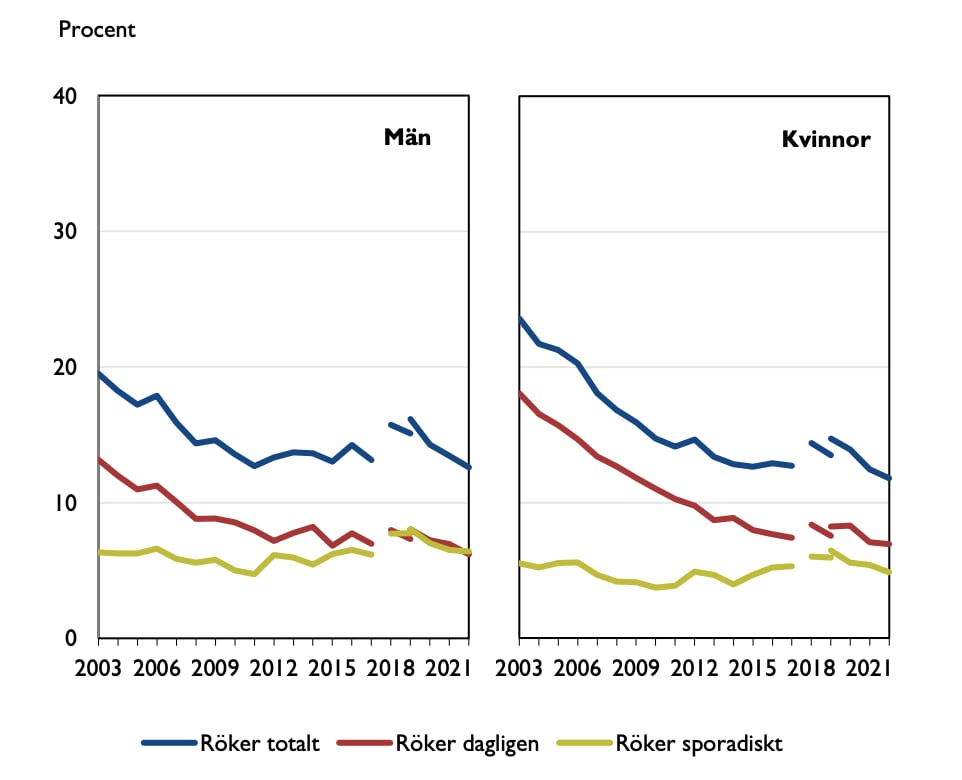How Sweden got close to stubbing out smoking for good

Sweden is on the brink of becoming the world's first smoke-free country, defined as a country where less than 5 percent of the population smokes daily. This puts it 17 years ahead of the EU's 2040 target. How did this happen?
As recently as 15 years ago, in 2008, 15 percent of the Swedish population smoked every day, a figure which has now been slashed to just over 5 percent, according to the most recent figures for 2022.
It is likely that daily cigarette use in Sweden will drop below 5 percent this year, meeting the criteria to be 'smoke free' in the definition used by the EU.
This means Sweden is likely to be the first country in the EU to meet the 2040 target, and indeed the first country in the world to be classed as smoke-free under the same metric.
To put that into perspective, the average daily smoking rate in the EU was 18.4 percent in 2019, when all but three countries (Finland, Iceland and Sweden) had a smoking rate of over 10 percent. When the EEA and EU candidate countries are included, ten countries had a smoking rate of over 20 percent, with Bulgaria and Turkey close to 30 percent at 28.7 percent and 27.3 percent, respectively.
Why are Sweden's figures so low?
There are a few reasons behind Sweden's low figures.
Firstly, the Swedish government has committed to being smoke-free by 2025, 15 years ahead of the EU-wide target.
Sweden is also a signatory to the World Health Organisation's Tobacco Convention, a legally-binding treaty which aims to use preventative measures to cut smoking rates, such as making products less easily accessible, lowering demand and social acceptance for smoking, and increasing access to methods and tools to aid people in giving up smoking.
Another key reason why Sweden's figures are so low is that Swedes consume nicotine in other ways, in the form of other products such as e-cigarettes or vapes, but most importantly in the form of snus, the small nicotine pouches popular in Sweden and neighbouring Norway, particularly among young men.
This is particularly obvious in the graph below, which shows the number of Swedes who smoke daily (this number is higher than the figures for cigarettes alone, as it includes not only traditional tobacco products such as cigarettes, pipes and cigars, but also products which do not include tobacco such as e-cigarettes and vapes), compared with the number of Swedes who use snus on a daily basis.
For men in particular, snus is clearly more popular than smoking, with 22.9 percent of the total 31.7 percent of daily nicotine users in 2022 choosing snus.
Women aren't far behind - 8.5 percent of women smoked a nicotine product daily, while 7.1 percent used snus.
In recent years, white snus - snus without tobacco - has also become more popular. While more men than women use traditional snus, the rates are roughly equal for white snus, according to a report by the Swedish Council for Information on Alcohol and Other Drugs (CAN).
In the following two graphs, it is even more obvious that the decrease in smoking occurred simultaneously with an increase in snus usage, particularly among women.
Cigarette smokers:
Cigarette smokers. The blue line is total smokers, the red is daily smokers and the green is occasional smokers. Graphs are split between men (män) and women (kvinnor). Source: Swedish Council for Information on Alcohol and Other Drugs (CAN)
Snus users:
 Snus users. The blue line is total users, the red is daily users and the yellow is occasional users. Split between men (män) and women (kvinnor). Source: Swedish Council for Information on Alcohol and Other Drugs (CAN)
Snus users. The blue line is total users, the red is daily users and the yellow is occasional users. Split between men (män) and women (kvinnor). Source: Swedish Council for Information on Alcohol and Other Drugs (CAN)
So, what does this mean from a public health perspective?
Well, it's undeniable that smoking tobacco is unhealthy, both for smokers and for the people around them. The World Health Organisation (WHO) estimates that smoking kills 8 million people a year worldwide, with over 1.2 million of those non-smokers exposed to second-hand smoke.
Smoking tobacco is a risk factor for many diseases, including heart diseases and different forms of cancer, particularly lung cancer.
It's not entirely clear whether snus is dangerous or not, although the fact that it doesn't produce second-hand smoke is a clear plus from a public health perspective.
Having said that, nicotine in itself is addictive and can cause high blood pressure, as well as a possible risk of stroke, heart attack or type-2 diabetes, so usage of snus or other nicotine products, whether they include tobacco or not, could still carry with it some risks.
Comments
See Also
As recently as 15 years ago, in 2008, 15 percent of the Swedish population smoked every day, a figure which has now been slashed to just over 5 percent, according to the most recent figures for 2022.
It is likely that daily cigarette use in Sweden will drop below 5 percent this year, meeting the criteria to be 'smoke free' in the definition used by the EU.
This means Sweden is likely to be the first country in the EU to meet the 2040 target, and indeed the first country in the world to be classed as smoke-free under the same metric.
To put that into perspective, the average daily smoking rate in the EU was 18.4 percent in 2019, when all but three countries (Finland, Iceland and Sweden) had a smoking rate of over 10 percent. When the EEA and EU candidate countries are included, ten countries had a smoking rate of over 20 percent, with Bulgaria and Turkey close to 30 percent at 28.7 percent and 27.3 percent, respectively.
Why are Sweden's figures so low?
There are a few reasons behind Sweden's low figures.
Firstly, the Swedish government has committed to being smoke-free by 2025, 15 years ahead of the EU-wide target.
Sweden is also a signatory to the World Health Organisation's Tobacco Convention, a legally-binding treaty which aims to use preventative measures to cut smoking rates, such as making products less easily accessible, lowering demand and social acceptance for smoking, and increasing access to methods and tools to aid people in giving up smoking.
Another key reason why Sweden's figures are so low is that Swedes consume nicotine in other ways, in the form of other products such as e-cigarettes or vapes, but most importantly in the form of snus, the small nicotine pouches popular in Sweden and neighbouring Norway, particularly among young men.
This is particularly obvious in the graph below, which shows the number of Swedes who smoke daily (this number is higher than the figures for cigarettes alone, as it includes not only traditional tobacco products such as cigarettes, pipes and cigars, but also products which do not include tobacco such as e-cigarettes and vapes), compared with the number of Swedes who use snus on a daily basis.
For men in particular, snus is clearly more popular than smoking, with 22.9 percent of the total 31.7 percent of daily nicotine users in 2022 choosing snus.
Women aren't far behind - 8.5 percent of women smoked a nicotine product daily, while 7.1 percent used snus.
In recent years, white snus - snus without tobacco - has also become more popular. While more men than women use traditional snus, the rates are roughly equal for white snus, according to a report by the Swedish Council for Information on Alcohol and Other Drugs (CAN).
In the following two graphs, it is even more obvious that the decrease in smoking occurred simultaneously with an increase in snus usage, particularly among women.
Cigarette smokers:

So, what does this mean from a public health perspective?
Well, it's undeniable that smoking tobacco is unhealthy, both for smokers and for the people around them. The World Health Organisation (WHO) estimates that smoking kills 8 million people a year worldwide, with over 1.2 million of those non-smokers exposed to second-hand smoke.
Smoking tobacco is a risk factor for many diseases, including heart diseases and different forms of cancer, particularly lung cancer.
It's not entirely clear whether snus is dangerous or not, although the fact that it doesn't produce second-hand smoke is a clear plus from a public health perspective.
Having said that, nicotine in itself is addictive and can cause high blood pressure, as well as a possible risk of stroke, heart attack or type-2 diabetes, so usage of snus or other nicotine products, whether they include tobacco or not, could still carry with it some risks.

Join the conversation in our comments section below. Share your own views and experience and if you have a question or suggestion for our journalists then email us at [email protected].
Please keep comments civil, constructive and on topic – and make sure to read our terms of use before getting involved.
Please log in here to leave a comment.